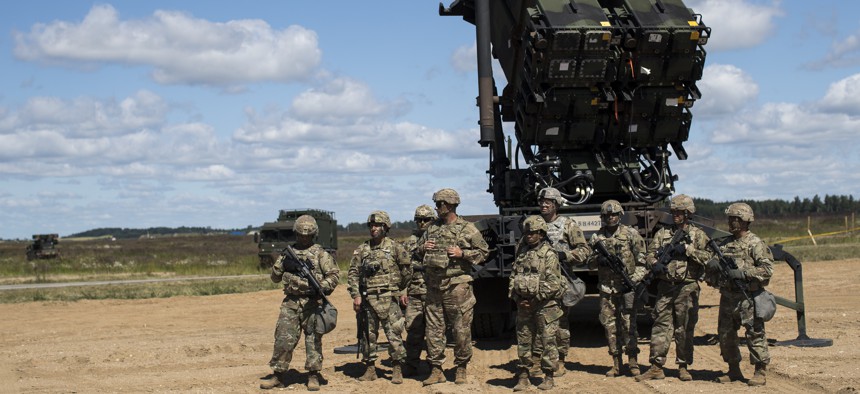
Members of US 10th Army Air and Missile Defense Command stands next to a Patriot surface-to-air missile battery during the NATO exercise "Tobruq Legacy 2017" at the Siauliai airbase near Vilnius, Lithuania, July 20, 2017. ap photo/mildaugus kulbis
White House Proposes Loan Fund to Help Allies Buy US Arms
It’s the second try for an idea shelved in 2017 when lawmakers disapproved.
The Trump administration wants to make it easier for partners and allies abroad to buy U.S. weapons and other defense equipment in an effort to draw them away from shopping with China and Russia, reviving a failed effort from the early days of the administration.
A State Department official said that it will be seeking up to $8 billion to offer more flexible loans that, according to the budget overview, will “make U.S. defense equipment a more competitive and more affordable option for partner countries.”
The loan fund would be in addition to an existing grant assistance fund available to dozens of nations worldwide, with the lion’s share annually going to Israel, Jordan and Egypt. (The budget asks for $5.4 billion for that program in 2020.) Trump has slimmed down the grant program since taking office, and in 2017, the White House in floated the idea of turning it into a “loan program.” But the idea appeared to have been shelved amid congressional resistance.
The broader authority under which the proposed fund would exist — controlled by the State Department but managed on a day-to-day basis by the Defense Department — provides financial assistance to countries to help them purchase everything from trucks to military training to fighter jets and drones. Although the loan program already exists, it has seldom been used and has largely been left unfilled in recent years. In 2016, the U.S. offered Iraq $250 million in an eight-year loan to help purchase munitions, aircraft maintenance and training during the fight against ISIS.
Related: Don’t Sell F-35 To Turkey If It Buys Russian SAMs: Top NATO General
Related: Foreign Weapons Get a Closer Look as the Pentagon Races to Rearm
Related: How Much Do America’s Arms Makers Depend on Foreign Metal? No One Seems to Know
Now, the State Department is requesting $8 billion to fill the fund — and additional authorities to offer potential customers more interest-rate flexibility. This has long been a top priority for the defense industry, said Colby Goodman, an expert on foreign security assistance at the Forum on Arms Trade.
The finer details of Trump’s proposal remain unclear. The devil is in the details, says Goodman, who suggests “‘flexible interest rate’ means lower interest rate and ‘more competitive’ loan program means lower guarantees and protections.”
“My general concern is this could lead to more loan defaults and taxpayers would end up footing the bill,” he said.
Wiiliam Hartung, the director of the Arms and Security Project at the Center for International Policy, raised similar concerns. In the 1980s, a number of loan programs failed due to missed payments, Hartung said; another effort to create a similar program under President Bill Clinton “collapsed under its own weight” when Congress insisted that the loan terms be on civilian footing. Absent more generous terms, countries weren’t interested.
Trump’s proposed loans will be targeted at countries that are purchasing military materiel from Russia and China, a move that dovetails with the U.S. military’s broader shift in focus from fighting terrorism to countering major powers — what the Pentagon calls “near peer adversaries.”
“Pretty much anywhere where we would like to see partners deepen and strengthen the relationship with U.S. by investing in the diplomatic partnership that comes with building your defense capabilities by buying American,” the State official said.
For now, the document is only a proposal, and it’s not clear that Congress will sign off. Lawmakers have balked in the past at the notion of turning the so-called Foreign Military Financing, or FMF, program into a loan program. Congress in 2017 demanded the administration provide a more fulsome assessment of the impacts of transitioning grants to loans.
“You have to show me where a loan is better for our national security,” Sen. Lindsey Graham, R-S.C., said at the time.



